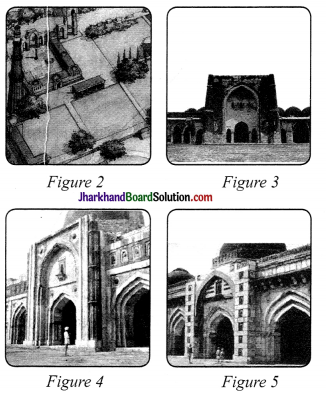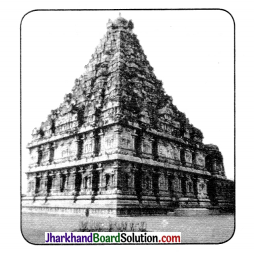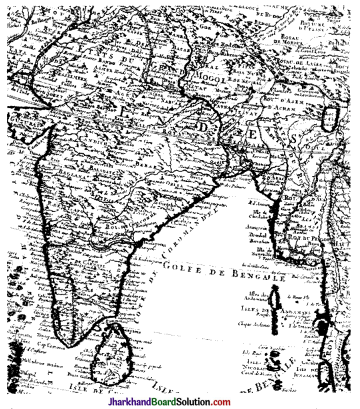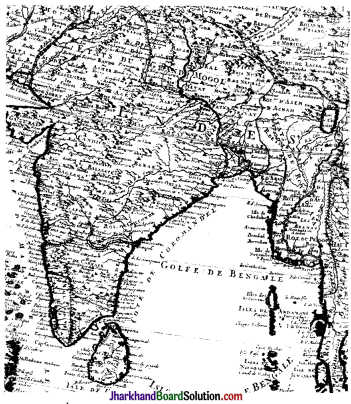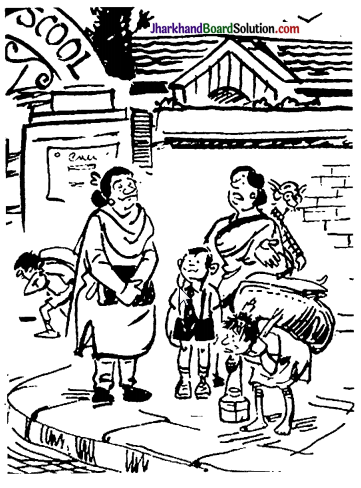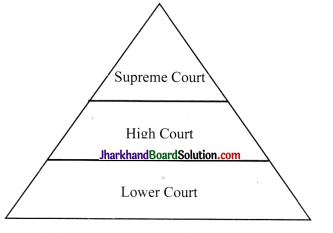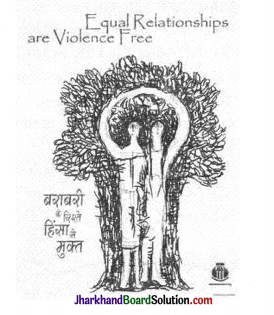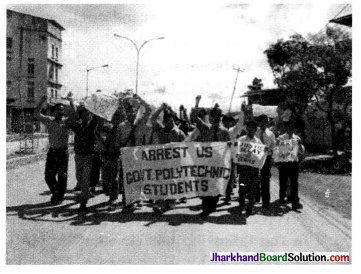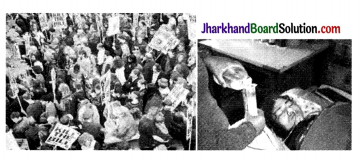JAC Board Class 7th Social Science Solutions History Chapter 4 The Mughal Empire
JAC Class 7th History The Mughal Empire InText Questions and Answers
Page 46
Question 1.
Do you think this painting suggests that the Mughals claimed kingship as a birthright?
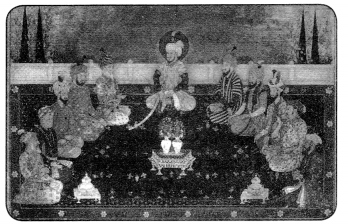
Answer:
As this painting portraits the hierarchy of the Mughal emperors right from Timur to Aurangzed, it depicts that the Mughals claimed kingship as a birthright.
Page 47
Question 2.
How was Humayum’s relationship with Safavid Iran different from Akbar’s?
Answer:
Humayum took refuge in the court of Safavid Iran when he was defeated by Sher Shah Suri. Therefore, he had friendly relations with Iran. Whereas, Akbar seized Kandahar from Safavid Iranian rulers. Hence, he was at war with them.
![]()
Question 3.
Did the annexation of Golconda and Bijapur in Aurangzeb’s reign end hostilities in the Deccan?
Answer:
No, in spite of the annexation of Golconda and Bijapur, Aurangzeb faced unending disturbances in Deccan as Marathas started guerrilla warfare against him.
Page 50
Question 4.
Which do you think is a fairer division of inheritance: primogeniture or coparcenary?
Answer:
Coparcenary is the fairer division of inheritance. It is based on the principle of equality.
Page 51
Question 5.
What was the consequence of Shivaji’s insult by Aurangzeb?
Answer:
When Aurangzeb insulted Shivaji, and when latter came to accept Mughal authority, Shivaji escaped from prison and began guerrilla warfare in Deccan against Mughals .
Question 6.
Would this have meant more expenditure for the state?
Answer:
Yes, the increase in number of mansabdars with higher zat rankings would have led to more expenditure for the State.
Page 55
Question 7.
Can you identify the Jesuit priests in this picture?
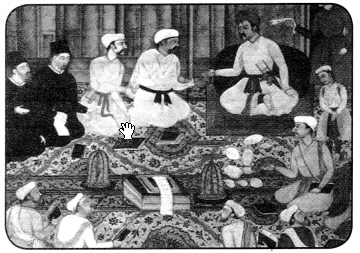
Answer:
Two persons wearing black robes are the Jesuit priests who are sitting on the upper left side in the picture.
Poge 57
Question 8.
Imagine you have inherited a kingdom. (Remember Babur and Akbar were about your age when they became rulers). How would you make your
Answer:
kingdom stable and prosperous? In order to make my kingdom stable and prosperous I will undertake following actions:
- I will reform administration, revenue, military and trade systems.
- I will try to uplift the common people such as peasants, artisans.
- I will check corruption in the court.
- I will tighten my hold on nobles.
- I will expand my kingdom.
- I will induct new war technology, etc.
JAC Class 7th History The Mughal Empire Textbook Questions and Answers
( Let’s Recall)
Question 1.
Match the following.
| Mansab | Marwar |
| Mongol | Governor |
| Sisodiya Rajput | Uzbeg |
| Rathor Rajput | Mewar |
| Nur Jahan | Rank |
Answer:
| Mansab | Rank |
| Mongol | Uzbeg |
| Sisodiya Rajput | Mewar |
| Rathor Rajput | Marwar |
| Nur Jahan | Jahangir |
| Subadar | Governor |
Question 2.
Fill in the blanks.
(a) The capital of Mirza Hakim, Akbar’s half-brother,was……..
(b) The five Deccan Sultanates were Berar, Khandesh, Ahmadnagar,……. and
(c) If zat determined a mansabdar’s rank and salary, sawar indicated his………
(d) Abul azl, Akbar’s friend and counsellor, helped him frame the idea of ………so that he could govern a society composed of many religions, cultures and castes.
Answer:
(a) Kabul
(b) Bijapur, Golconda
(c) number of cavalrymen
(d) sulh-i-kul
![]()
Question 3.
What were the central provinces under the control of the Mughals?
Answer:
The central provinces under the control of the Mughals were Delhi, Kabul, Sind, Marwar, Gujarat, Mewar, Bihar, Bengal, Orissa and Deccan.
Question 4.
What was the relationship between the mansabdar and the jagirl
Answer:
Mansabdars received the salary as revenue assignment which was called jagir. They didn ’t administer their jagirs. The revenue was collected for them by their servants while the mansabdars were working in some other parts of the province.
(Let’s Understand)
Question 5.
What was the role of the zamindars in Mughal administration?
Answer:
The role of the zamindars in Mughal administration is as follows:
Zamindars were the local headmen of the villages or a powerful chieftains appointed by the Mughal emperor. They worked as intermediaries. They were responsible for collecting taxes from peasants and deposited them with the treasurer.They also played a role of mnning the administration of the Mughals.1 Sometimes they became rebellious against the Mughal empire as they exercised a great deal of power.
Question 6.
How were the debates with religiousscholars important in the formation of Akbar’s ideas on governance?
Answer:
During the 1570s, Akbar had a discussion on religion with the Ulama, ” Brahmanas, Jesuit priests who were Roman Catholics and Zoroastrians. These discussions took place during his stay at Fatehpur Sikri in the ibadat 1 khana. Akbar was interested in thereligion and social customs of different people and his interaction with people of different faiths made him realise that their teachings created divisions and disharmony among his subjects.
Thus Akbar came to an idea known as ‘sulh-i kul’ which focused on a system of ethics honesty, justice and peace.Abul Fazl helped Akbar in framing a vision of governance around this idea of sulh-i kul, which was also followed by ‘ Jahangir and Shah Jahan as well.
Question 7.
Why did the Mughals emphasise their Timurid and not their Mongol descent?
Answer:
The Mughals emphasised on their Timurid and not their Mongol descent because the memory of Mongol emperor Genghis Khan was associated with the massacre of a vast number of people. It was also linked with the Uzbegs, their Mongol competitors. On the other hand, the Mughals took pride in the fact that Timur ancestry had captured the city of Delhi in 1398.
(Let’s Discuss)
Question 8.
How important was the income fromland revenue to the stability of the Mughal Empire?
Answer:
The income from land revenue led to thestability of the Mughal Empire because it was the main source of income of the Mughal Empire. It strengthened the economic system of the Mughal Empire. A huge amount of finance was needed to meet the administrative purpose and maintaining law and order which came from the revenue.It was important as they had to pay the salaries to the soldiers and officials and do welfare works for the common people.Its importance can be easily assessed from the fact that Todar Mai, Akbar ‘s revenue minister,, took 10-year period to carry out the proper calculation of land revenue.
![]()
Question 9.
Why was it important for the Mughals to recruit mansabdars from diverse backgrounds and not just Turanis and Iranis?
Answer:
It was important for the Mughals to recruit mansabdars from diverse backgrounds and not just Turanis and Iranis because Mughal empire expanded to different regions. Hence, the problems of common folks would be understood better by the people living with them. This included Rajputs, Marathas, Afghans, Muslims and other groups. They came here to rule, so they needed to respect the diversity of the country in order to have a control over it.
Question 10.
Like the Mughal Empire, India today is also made up of many social and cultural units. Does this pose a challenge to national integration?
Answer:
Like the Mughal Empire, India today is also made up of many social and cultural units. This does not pose a challenge to national integration because of the following reasons: India follows a tradition of ‘unity in diversity’. All religions are equally reckoned by the constitution. Now-a-days, people get the right to choose their government and freedom to do what they want which was not same under the reign of Mughals. No, the gap in the income between the rich and the poor in India has not changed a great deal from the period of the Mughals, but the incomes have highly increased compared to that period.Some special advantages are also given to the weaker sections of the society for the upliftment of their living standards.
Question 11.
Peasants were vital for the economy of the Mughal Empire. Do you think that they are as important today? Has the gap in the income between the rich and the poor in India changed a great deal from the period of the Mughals?
Answer:
Peasants were vital for the economy ofthe Mughal Empire. Therefore, today’s economy does not totally depend upon peasants. Yes, they are important today as well.No, , the gap in the income between the rich and the poor in India has not changed a great deal from the period of the Mughals, but the incomes have highly increased compared to that period.
(Let’s Do)
Question 12.
The Mughal Empire left its impact on the different regions of the subcontinent in a variety of ways. Find out if it had any impact in the city/village/region in which you live.
Answer:
The Mughal Empire left its impact on thedifferent regions of the subcontinent in a variety of ways. It had many impact in the city, village, region in which we live. Urdu has enriched our literature, music and art of writing. Their contributions made the cities rich and colourful. As we can discuss about Delhi. It was the capital of Mughal Empire. We see many monuments and beautiful architecture.
JAC Class 7th History The Mughal Empire Important Questions and Answers
Multiple Choice Questions
Question 1.
Name the ruler whose mother was a descendant of the greatest Mongol warrior, Ghengis Khan, and his father descended from the legendary Timur.
(a) Babur
(b) Humayun
(c) TodarMal
(d) Jahangir
Answer:
(a) Babur
Question 2.
Babur was forced to leave his ancestral land and came to India and set up the first Mughal empire because
(a) He was a born tourist
(b) His younger brother wanted to become a king
(c) There was a drought in his ancestral land
(d) The Uzbegs invaded his ancestral land, Ferghana.
Answer:
(d) The Uzbegs invaded his ancestral land, Ferghana.
Question 3.
Humayun recaptured Delhi in 1555 with the help of
(a) Muhammad Ali of Africa
(b) Sher Khan of Afghanistan
(c) Ali Zafar of Turkey
(d) Safavid Shah of Persia (Iran)
Answer:
(d) Safavid Shah of Persia (Iran)
![]()
Question 4.
Who became the emperor at the age of 13 and reigned from 1556 to 1605?
(a) Jahangir
(b) Akbar
(c) Humayun
(d) Shahjahan
Answer:
(b) Akbar
Question 5.
After Akbar, who continued his military campaigns and forced the Sisodiya Rajputs to accept the Mughal rule?
(a) Jahangir
(b) Bahadur Shah Zafar
(c) Shah Jahan
(d) None of these
Answer:
(a) Jahangir
Question 6.
Genghis Khan was the emperor of
(a) Central Asia
(b) China
(c) Mongol tribes
(d) All of these
Answer:
(d) All of these
Question 7.
Sulh-i-kul means
(a) Unity
(b) Gender discrimination
(c) Universal peace
(d) Payment equality
Answer:
(c) Universal peace
Question 8.
Which Mughal emperor was also known as Salim?
(a) Humayun
(b) Jahangir
(c) Akbar
(d) Shah Jahan
Answer:
(b) Jahangir
Question 9.
The salary of the mansabdars were known as…….
(a) Zabt
(b) Jat
(c) Jagir
(d) Mansab
Answer:
(c) Jagir
Question 10.
Akbar Nama was written by …….
(a) Todar Mai
(b) Birbal
(c) Tansen
(d) Abul Fazl
Answer:
(d) Abul Fazl
Very Short Answer Type Questions
Question 1.
What does Mansab mean?
Answer:
Mansab means position or rank.
Question 2.
What do you mean by the rule of primogeniture?
Answer:
By the rule of primogeniture, the elder son inherits the father’s property.
Question 3.
Ibrahim Lodi was defeated by Babur in which year and battle?
Answer:
Ibrahim Lodi was defeated by Babur in 1526 in the first battle of Panipat.
![]()
Question 4.
Whom did Sher Khan defeated in the battle of Chausa and Kanauj?
Answer:
Sher Khan defeated Humayun in the battle of Chausa and Kanauj.
Question 5.
What was the other name of Prince Khurram assumed after he ascended the throne?
Answer:
Prince Khurram was named Shah Jahan when he ascended to the throne in 1627 after the death of Jahangir.
Question 6.
What do you mean by zat?
Answer:
Zat is a numerical value which determines the ranks and salaries. If zat is on higher side then the noble’s position is also a prestigious one and a big salary as well.
Question 7.
Who fought guerilla warfare?
Answer:
The Marathas fought the guerilla warfare.
Question 8.
In Iran, who helped and gave shelter to Humayun when he fled there?
Answer:
In Iran, Safavid Shah helped Humayun when he fled there.
Question 9.
Who was Genghis Khan?
Answer:
Genghis Khan was the king of the Mongol tribe, Central Asia and China.
![]()
Question 10.
Who established the chain of justice?
Answer:
Jahangir, the Mughal emperor established the chain of justice outside his palace.
Short Answer Type Questions
Question 1.
Under the Mughals, what was the relationship between rank and salary?
Answer:
Zat, a numerical value helped in determining the rank and salary of the nobles. A grading system, ‘mansab’ was used to fix the rank, salary and military responsibilities.
Question 2.
What do you mean by Dogma and Bigot,
Answer:
Dogma is a statement or a connotation declared as authoritative with the expectation that it would be followed without question.
Bigot is an individual who is intolerant of another person’s religious beliefs or culture.
Question 3.
Whom did Aurangzeb insulted when he came to accept Mughal authority? What was the outcome of this insult?
Answer:
Aurangzeb insulted Shivaji when he came to accept Mughal authority. The outcome of this insult was that Shivaji escaped from Agra, declared himself an independent king and resumed his .campaigns against the Mughals.
Question 4.
What were the major events happened during Shahjahan’s reign?
Answer:
Under Shah Jahan, Mughal campaigns continued in the Deccan. The Afghan noble, Khan Jahan Lodi was defeated as he became rebellious. Campaigns were launched against Ahmadnagar, the Bundelas were also defeated and Orchha was seized. In the north-west, the campaign to seize Balkh from the Uzbegs was not successful and Question andahar was lost to the Safavids. In 1632, Ahmadnagar was finally annexed and the Bijapur forces sued for peace.
Question 5.
Babur was the first Mughal emperor. How he became an emperor and of which place?
Answer:
Babur was the first Mughal emperor (1526-1530), succeeded to the throne of Ferghana in 1494 when he was only 12 years old. Due to the invasion of another Mongol group, the Uzbegs, he was forced to leave his ancestral throne. After years of wandering he seized Kabul in 1504. In 1526, he defeated the Sultan of Delhi, Ibrahim Lodi, at Panipat which is called as First Battle of Panipat and captured Delhi and Agra. Hence, led the foundation of Mughal Empire.
Question 6.
Akbar had a discussion with people of different faiths. What did he realize after the discussion?
Answer:
On his discussion with people of different faiths, Akbar realized that the religious scholars who emphasized rituals and dogma were often bigots. Their teachings mainly created disharmony and divisions amongst the subjects.
![]()
Question 7.
Write at least two instances of the Mughal marrying the Rajput women.
Answer:
Instances of the Mughal marrying the Rajput women are: The Kachhwaha princess, daughter of the Rajput ruler of Amber was the mother of Jahangir.
A Rathore princess, daughter of the Rajput ruler of Marwar was the mother of Shah Jahan.
Question 8.
What was Akbar’s religious policy?
Answer:
- Akbar’s religious policy was as under:
- Akbar introduced the idea of sulh-i-kul or “universal peace”.
- This idea of tolerance did not discriminate between people of different religions in his realm.
- Instead it focused on a system of ethics- honesty, justice and peace-that was universally applicable.
Question 9.
Write a note on Humayun.
Answer:
Humayun was the son of Babur. According to the will of his father, Humayun divided his inheritance. His brothers were each given a province. The ambitions of his brother Mirza Kamran weakened Humayun’s cause against Afghan competitors. Sher Khan defeated Humayun at Chausa (1539) and Kanauj (1540), and he fled to Iran. In Iran, Humayun received support from Safavid Shah. He recaptured Delhi in 1555 but died the next year after an accident.
Question 10.
What power and potential did the nobles exercise during Akbar’s reign?
Answer:
During Akbar’s reign, nobles commanded large armies and had access to large amounts of revenue. While they were loyal to the empire, they even functioned efficiently and effectively but by the end of the seventeenth century many nobles had built independent networks of their own. Their loyalties to the empire were weakened by their own self-interest.
Long Answer Type Questions
Question 1.
Describe Akbar Nama and Ain-i- Akbari.
Answer:
A three-volume history of Akbar’s reign, titled Akbar Nama was written by Abul Fazl. The first volume dealt with Akbar’s ancestors and the second volume recorded the events of Akbar’s reign. The third volume is the Ain-i-Akbari. It majorly deals with Akbar’s administration, army, household, revenues and the geography of his empire. It also provides important details about the traditions and culture of the people living in India. The most interesting aspect about the third volume, Ain-i-Akbari is its rich statistical details about things as diverse as crops, yields, prices, wages and revenues.
The descriptive features of administration was explained in Ain-i-Akbari. The empire was divided into provinces called subas which were governed by a subadar who carried out both political and military functions. And each province also had a financial officer or diwan. For the maintenance of peace and order, the subadar was supported by other officers mainly the military paymaster (bakhshi), the minister in charge of religious and charitable patronage (sadr), military commanders (faujdars) and the town police commander (kotwal).
![]()
Question 2.
The peasantry suffered tremendously in the last years’of Aurangzeb’s reign. Explain.
Answer:
During Akbar’s reign, the jagirs were carefully assessed so that their revenues were more or less equal to the salary of the mansabdar. But during Aurangzeb’s reign this was no longer the case. The actual revenue collected was often less than the granted sum. There was also a huge increase in the number of mansabdars, which meant a long wait before they received a jagir. Hence, these and other factors created a shortage in the number of jagirs. Therefore, many jagirdars tried to extract as much revenue as possible while they had a jagir. So, Aurangzeb was unable to control these developments in the last years of his reign and the peasantry therefore suffered tremendously.
